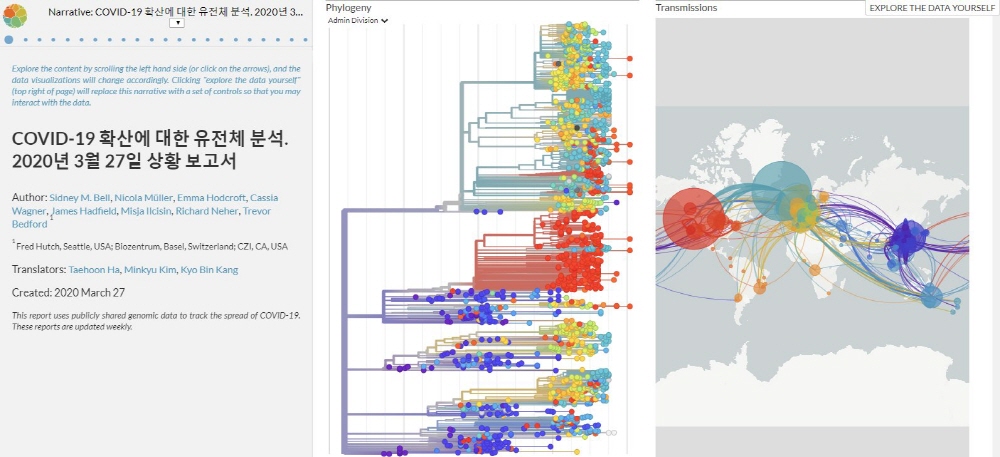
Nextstrain is an open source project that published a detailed report by drawing the enlarged virus infection using a world map and phylogenetic tree based on the virus gene sequence data collected from patients provided by research institutes around the world. NextStrain’s Corona 19 (SARS-CoV-2) related report is also available in Korean.
According to Trevor Bedford, co-founder of NextStrain and a biologist working at the Hutchinson Cancer Research Center, NextStrain provides more than 2,000 corona 19 gene sequence data, which can be analyzed to accurately track where the virus came from.
According to Bedford, when the Ebola outbreak in West Africa in 2014 took a sample of the virus, sequenced the genome and released the data, it took a year. However, since many research institutes now provide samples, the same process can be performed for only 2 to 7 days, and this effect makes it possible to use the report released by NextStrain in real time for countermeasures against diffusion.
The Korean version of the Corona 19 Situation Report released by NextStrain was released on March 27th. Bedford is analyzing data on the sequence of 2,000 different types of genes, but the March 27 report says it has analyzed 1,495 publicly shared genomes. This is a mutation of the corona virus and can be traced to identify the source of virus infection. In addition, according to NextStrain, it is possible to analyze viral gene sequence data collected from 48 countries on six continents, and to share the data in a timely manner and the incredible work of scientists and doctors around the world.
You can also visually see the number of COVID-19 sample data provided by country on a world map. NextStrain says that there is little data in the southern hemisphere, such as the fact that Corona 19 is not yet prevalent in the southern hemisphere and there is little data available.
When looking at the corona 19 gene sequence data provided in Europe as a phylogenetic tree and a map, the phylogenetic tree represents the mutant virus, and the horizontal axis represents the degree of viral genome difference. The phylogenetic tree shows viral genome samples taken from Europe, classified by country. It should be noted that, while some small clusters by country are visible, samples from other countries are complexly mixed. In response, NeXTrain said it suggests that there has been a continuous spread across borders in the last 3-5 weeks in Europe.
The pattern of infection spread within the United States is quite complex. In the case of CT, for example, many of the latest samples have spread in Washington state, but several clusters are mixed at the same time. NeXTrain stresses that although conclusive conclusions require more data, it suggests that the infection is spreading over considerable distances in the United States. He stresses that the patterns of spread in the United States are far more complex than those currently available. The presence of additional data will help us understand how the spread in the United States is occurring.
In Washington State, there are at least two separate localized infection clusters, each of which has a different origin. One is said to have originated in China, and the other is said to have originated in Europe.
In Central and South America, there is not much data on the Corona 19 sample. Most of the outbreaks in Latin America are samples taken from travelers. As can be seen from the splendid phylogenetic tree, travelers from other countries cause the outbreak of Corona 19 infection in Latin America. In addition, cases unrelated to travelers are starting to be reported in Central and South America, but there are few samples, so it is not yet possible to report detailed situations.
The Asian case has not been sampled for the virus in Iran. However, there seems to be some genetic sequence data from cases reported on a trip to Iran. Viral gene sequences collected from cases with a history of traveling to Iran can be grouped. This suggests that many Iranian cases are based on the spread of the Ilda virus.
In the African Republic of Congo, a new strain of COVID-19 is being discovered in its capital, suggesting that it has gone through a complex transmission route. In addition, in the case of Oceania, Corona 19 spread locally in New South Wales, Australia, and there is a possibility that the virus was prevalent in this area at the latest in late February.
NextStrain will make prosecutions widely free of charge by administrative agencies, more aggressive measures to address social distancing, fund widespread contact tracking, and measures related to social distancing There are four things that will be supported economically. In addition, social distancing for vulnerable groups should be strictly enforced from those conducted by individuals. Even if they are not vulnerable, people around themselves should recognize the possibility of being vulnerable and are in bad condition according to practices such as restricting movement to protect others. If possible, stay at home and quarantine as often as possible, and if you are an employer, allow an employee to wait at home if you have the disease. Related information can be found here .


















Add comment